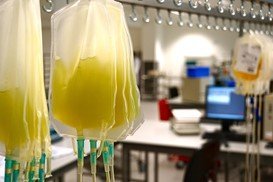What is the impact of repeated plasma donation on donor health?
08/04/24

Strengthening voluntary non-remunerated plasma collection capacity in Europe is an important and major challenge in the upcoming years (https://supply-project.eu/).
One of the important questions to address is how Europe can become more self-sufficient: should we increase the plasma donation frequency in existing donors or should we include more donors at a lower frequency?
To answer this question, we executed a randomized controlled trial to assess the impact of plasma donation frequency on donor health.
We included 63 male participants who were randomly allocated into 4 groups: low-frequency (LF, once/month), high-frequency (HF, three times/month), very high-frequency (VHF, two times/week) and a placebo (P, once/month). Each group adhered to the allocated donation frequency regimen over three months.
Key findings were that:
- VHF may result in a large and clinically relevant reduction in immunoglobulin G (<6 g/L) and ferritin levels (<24 µg/L);
- No (important) impact of repeated plasma donation on other biochemical or physiological parameters was observed;
- Few (minor) adverse events were reported after HF and VHF plasma donation.
These results support the pathway to increase plasma supply by increasing the number of low-frequent plasma donors rather than increasing the frequency in an existing donor pool.
The results of this study were published in Vox Sanguinis and were included in our systematic review (which was posted on a pre-print server and will be published in a peer-reviewed journal at a later stage in 2024).
This study was a collaboration between the Blood Services of Belgian Red Cross-Flanders and the Institute of Neuroscience and the Center of Investigation in Clinical Nutrition of the Université catholique de Louvain (Louvain-la-Neuve, Belgium).
